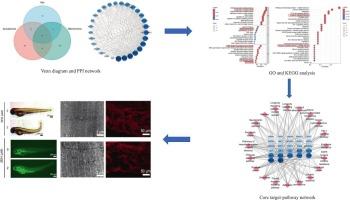玉米赤霉烯酮加速衰老和线粒体功能障碍:来自网络毒理学和斑马鱼模型的证据。
IF 4.3
3区 环境科学与生态学
Q2 BIOCHEMISTRY & MOLECULAR BIOLOGY
Comparative Biochemistry and Physiology C-toxicology & Pharmacology
Pub Date : 2025-08-11
DOI:10.1016/j.cbpc.2025.110325
引用次数: 0
摘要
玉米赤霉烯酮(ZEN)是一种普遍存在的真菌毒素,污染谷物和饲料,最著名的是生殖毒性。长期、低水平的暴露是否也会导致衰老和线粒体衰退仍不得而知。在这里,我们结合网络毒理学,分子对接,转录组学和斑马鱼(Danio rerio)模型来解决这个问题。计算机分析确定了30个与衰老或线粒体生物学相关的高可信度ZEN靶点;AKT1、MAPK3、TP53和NFKB1成为中心枢纽。对接预测了纳米摩尔范围内的亲和力(-6.2至-8.3 kcal/mol), 100 ns分子动力学模拟证实了稳定的络合物形成。将这些预测转化为一个生命系统,我们将斑马鱼幼虫暴露在2 μM ZEN中。在72 h内,这产生了明显的发育毒性(延迟孵化,心动过缓,骨骼畸形)和肌肉减少样肌肉变性。透射电镜显示组织紊乱的肌瘤;免疫染色显示肌球蛋白重链表达降低。氧化应激(DCF荧光)显著升高,atp合成酶转录物下调。96 h时的运动分析显示选择性地丧失了高速游泳运动。RNA-seq证实了MAPK、PI3K-AKT和凋亡通路的失调;长寿相关基因(igf1, sirt1, nfkb2)被显著抑制。总的来说,我们的工作提供了第一个综合证据,证明膳食ZEN通过线粒体功能障碍加速了机体衰老,并表明随着人口年龄的增长,有必要加强真菌毒素监测。本文章由计算机程序翻译,如有差异,请以英文原文为准。

Zearalenone accelerates aging and mitochondrial dysfunction: Evidence from network toxicology and zebrafish models
Zearalenone (ZEN), a ubiquitous mycotoxin contaminating cereals and feed, is best known for reproductive toxicity. It remains unclear whether chronic, low-level exposure contributes to aging and mitochondrial decline. Here, we combine network toxicology, molecular docking, transcriptomics and zebrafish (Danio rerio) models to address this question.
In silico analyses identified 30 high-confidence ZEN targets linked to aging or mitochondrial biology; AKT1, MAPK3, TP53 and NFKB1 emerged as the central hubs. Docking predicted strong binding affinities (−6.2 to −8.3 kcal/mol) and 100 ns molecular-dynamics simulations confirmed stable complex formation.
Translating these predictions to a living system, we exposed zebrafish larvae to 2 μM ZEN. Within 72 h this produced overt developmental toxicity (delayed hatching, bradycardia, skeletal malformations) and sarcopenia-like muscle degeneration. Transmission-electron microscopy revealed disorganised sarcomeres; immunostaining showed reduced myosin heavy-chain expression. Oxidative stress (DCF fluorescence) rose markedly, while ATP-synthase transcripts were down-regulated. Locomotor assays at 96 h revealed a selective loss of high-speed swimming bouts. RNA-seq corroborated dysregulation of MAPK, PI3K–AKT and apoptosis pathways; longevity-linked genes (igf1, sirt1, nfkb2) were significantly downregulated.
Collectively, our work provides the first integrated evidence that ZEN exposure accelerates organismal aging through mitochondrial dysfunction and suggests that tighter mycotoxin surveillance is warranted as populations grow older.
求助全文
通过发布文献求助,成功后即可免费获取论文全文。
去求助
来源期刊
CiteScore
7.50
自引率
5.10%
发文量
206
审稿时长
30 days
期刊介绍:
Part C: Toxicology and Pharmacology. This journal is concerned with chemical and drug action at different levels of organization, biotransformation of xenobiotics, mechanisms of toxicity, including reactive oxygen species and carcinogenesis, endocrine disruptors, natural products chemistry, and signal transduction with a molecular approach to these fields.

 求助内容:
求助内容: 应助结果提醒方式:
应助结果提醒方式:


